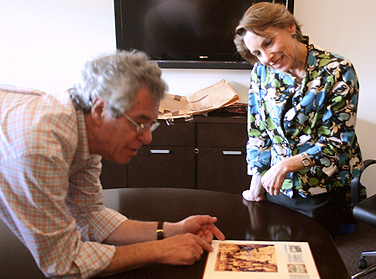News
Move downtown is paying off

Guy Gunzberg, great-grandson of M. Wile founder Mayer Wile, recently toured the Regional Institute’s renovated offices and shared some vintage photos of the building with institute director Kathryn Foster.
-
 Print
Print -
 Comments
Comments
-
“We’re here, and we’re settled, and we are confident that this was the right decision.”
The UB Regional Institute’s December move from the South Campus to the UB Downtown Gateway on Goodell Street is starting to pay off, advancing the university master plan that calls for creating a vibrant, world-class campus in the heart of Buffalo.
The new location places the research and policy center, which informs policymaking, investment decisions and civic debate for the Buffalo Niagara region, within walking distance of the offices of government, business and civic partners, including the Federal Reserve, Buffalo Niagara Enterprise and Community Foundation for Greater Buffalo. Meetings that used to take place over the phone now happen over lunch in the Theater District’s Bijou Grille, or Sea Bar on Ellicott Street.
Staff members also have begun developing relationships with fellow Downtown Gateway tenants, including the Buffalo Employment and Training Center, which now has a seat on a committee advising the institute on a labor market assessment. Another Gateway occupant, UBMD, the practice plan covering more than 450 School of Medicine and Biomedical Sciences physicians, has approached the institute to discuss a possible project: an analysis of possible new sites for a group of doctors exploring relocation.
Such access to collaborators is crucial for the institute, which partners with academic researchers, governments, foundations, businesses, civic groups and nonprofits to inform regional issues with independent research, innovative products and community outreach. Among recent projects are an examination of the value of UB partnerships with innovation enterprises; national research on bi-national environmental collaboration; an assessment of the status of women and girls in Western New York; and policy briefs analyzing such issues as local government downsizing and the exodus of youth from the region.
The five-story Downtown Gateway, formerly the M. Wile Building, is a historical landmark–the former home of the M. Wile & Company factory for men’s clothing. UB facilities and space planners, who designed the Regional Institute’s third-floor digs, preserved such industrial accents as thick, concrete pillars while giving the place a modernist upgrade: clean, white paint; hanging light fixtures; lime green ergonomic chairs; and offices enclosed with glass and sliding, metal doors. Employees jot down vacation dates on a white-board calendar built into the kitchen’s cubicle walls.
The cutting-edge design has nurtured a “collaborative energy,” says Rachel Teaman, the institute’s director of programs and communications. While she and her colleagues enjoyed their former South Campus home in Beck Hall, their desks there were spread over three stories, and “when you have to travel two flights of stairs to talk to someone, you think twice,” she says. Conversations often would occur via e-mail.
The institute also was Beck Hall’s only tenant, an isolating position. Besides the institute and UBMD, the Downtown Gateway houses the Office of Economic Engagement in the Division of External Affairs. Also scheduled to move in are the offices of Government and Community Relations, the Center for Entrepreneurial Leadership and the departments of Family Medicine and Anesthesiology. An atrium will connect the structure to an adjacent building UB is developing for the Educational Opportunity Center.
The Regional Institute’s new proximity to many local organizations and public agencies makes it an ideal gathering spot, and other UB offices have hosted events there. President John B. Simpson, for instance, welcomed members of the community and press to the new space for the launch of his Opportunities Advisory Council earlier this year. Guy Gunzberg, great-grandson of M. Wile founder Mayer Wile, toured the renovated offices in May.
"We’re here, and we’re settled, and we are confident that this was the right decision," institute director Kathryn Foster says. "I don’t think anyone on the staff has looked back."
"Our new home shows off UB well," she adds. "It’s modern. It’s hip."
She notes that her unit’s move represents just part of UB’s expanding downtown presence under the university’s comprehensive physical plan, one component of the UB 2020 long-range planning initiative. On a recent Wednesday afternoon, she admires the view, looking north, through the many windows of the Regional Institute’s conference room. Across Goodell, on the other side of a parking lot, lies the Buffalo Niagara Medical Campus, including UB's New York State Center of Excellence in Bioinformatics and Life Sciences, a sleek, silver building. Not far from there, the 10-floor UB and Kaleida Health global vascular institute is taking shape. Besides patient beds, operating rooms and laboratories, the facility will house UB’s Clinical Translation Research Center and the UB Biosciences Incubator.
Besides catalyzing collaboration among internal offices and community partners, UB’s growing downtown footprint also is making a difference in more informal ways. Employees patronize local businesses at the end of the day and during breaks, whether to grab a coffee or purchase flowers or small gifts, Foster says. Ulrich’s tavern is a popular post-work destination for colleagues looking to wind down, network and have a good time.
The Regional Institute’s relocation lengthened the commutes of some staff members and created other inconveniences. Teaman, for one, can no longer walk to her daughter’s South Campus day care center, as she could from Beck Hall. Dropping off and picking up her little girl is now a more time-consuming errand.
But she is not complaining. She, like Foster, believes the benefits of the move—more visibility for the institute and stronger relationships with collaborators—far outweigh any cons. And she suspects that those benefits will only grow as the institute becomes more established and UB brings more campus offices downtown.

Reader Comments